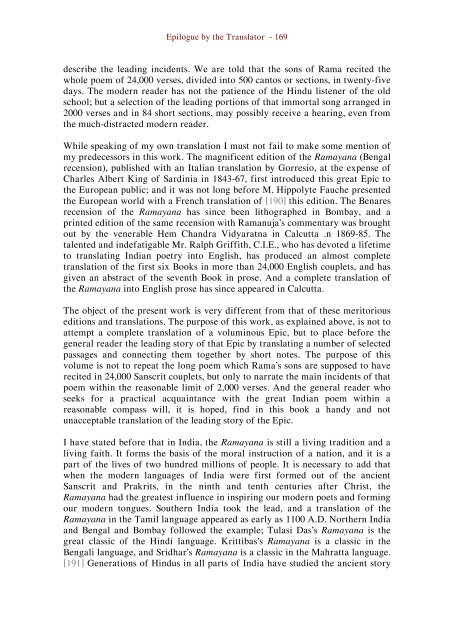Ramayana, Epic of Rama, Prince of India
An Abbreviated Translation of the Indian Classic, the Ramayana by Romesh Chundar Dutt in 2,000 verses
An Abbreviated Translation of the Indian Classic, the Ramayana by Romesh Chundar Dutt in 2,000 verses
You also want an ePaper? Increase the reach of your titles
YUMPU automatically turns print PDFs into web optimized ePapers that Google loves.
Epilogue by the Translator - 169<br />
describe the leading incidents. We are told that the sons <strong>of</strong> <strong>Rama</strong> recited the<br />
whole poem <strong>of</strong> 24,000 verses, divided into 500 cantos or sections, in twenty-five<br />
days. The modern reader has not the patience <strong>of</strong> the Hindu listener <strong>of</strong> the old<br />
school; but a selection <strong>of</strong> the leading portions <strong>of</strong> that immortal song arranged in<br />
2000 verses and in 84 short sections, may possibly receive a hearing, even from<br />
the much-distracted modern reader.<br />
While speaking <strong>of</strong> my own translation I must not fail to make some mention <strong>of</strong><br />
my predecessors in this work. The magnificent edition <strong>of</strong> the <strong><strong>Rama</strong>yana</strong> (Bengal<br />
recension), published with an Italian translation by Gorresio, at the expense <strong>of</strong><br />
Charles Albert King <strong>of</strong> Sardinia in 1843-67, first introduced this great <strong>Epic</strong> to<br />
the European public; and it was not long before M. Hippolyte Fauche presented<br />
the European world with a French translation <strong>of</strong> [190] this edition. The Benares<br />
recension <strong>of</strong> the <strong><strong>Rama</strong>yana</strong> has since been lithographed in Bombay, and a<br />
printed edition <strong>of</strong> the same recension with <strong>Rama</strong>nuja’s commentary was brought<br />
out by the venerable Hem Chandra Vidyaratna in Calcutta .n 1869-85. The<br />
talented and indefatigable Mr. Ralph Griffith, C.I.E., who has devoted a lifetime<br />
to translating <strong>India</strong>n poetry into English, has produced an almost complete<br />
translation <strong>of</strong> the first six Books in more than 24,000 English couplets, and has<br />
given an abstract <strong>of</strong> the seventh Book in prose. And a complete translation <strong>of</strong><br />
the <strong><strong>Rama</strong>yana</strong> into English prose has since appeared in Calcutta.<br />
The object <strong>of</strong> the present work is very different from that <strong>of</strong> these meritorious<br />
editions and translations. The purpose <strong>of</strong> this work, as explained above, is not to<br />
attempt a complete translation <strong>of</strong> a voluminous <strong>Epic</strong>, but to place before the<br />
general reader the leading story <strong>of</strong> that <strong>Epic</strong> by translating a number <strong>of</strong> selected<br />
passages and connecting them together by short notes. The purpose <strong>of</strong> this<br />
volume is not to repeat the long poem which <strong>Rama</strong>’s sons are supposed to have<br />
recited in 24,000 Sanscrit couplets, but only to narrate the main incidents <strong>of</strong> that<br />
poem within the reasonable limit <strong>of</strong> 2,000 verses. And the general reader who<br />
seeks for a practical acquaintance with the great <strong>India</strong>n poem within a<br />
reasonable compass will, it is hoped, find in this book a handy and not<br />
unacceptable translation <strong>of</strong> the leading story <strong>of</strong> the <strong>Epic</strong>.<br />
I have stated before that in <strong>India</strong>, the <strong><strong>Rama</strong>yana</strong> is still a living tradition and a<br />
living faith. It forms the basis <strong>of</strong> the moral instruction <strong>of</strong> a nation, and it is a<br />
part <strong>of</strong> the lives <strong>of</strong> two hundred millions <strong>of</strong> people. It is necessary to add that<br />
when the modern languages <strong>of</strong> <strong>India</strong> were first formed out <strong>of</strong> the ancient<br />
Sanscrit and Prakrits, in the ninth and tenth centuries after Christ, the<br />
<strong><strong>Rama</strong>yana</strong> had the greatest influence in inspiring our modern poets and forming<br />
our modern tongues. Southern <strong>India</strong> took the lead, and a translation <strong>of</strong> the<br />
<strong><strong>Rama</strong>yana</strong> in the Tamil language appeared as early as 1100 A.D. Northern <strong>India</strong><br />
and Bengal and Bombay followed the example; Tulasi Das’s <strong><strong>Rama</strong>yana</strong> is the<br />
great classic <strong>of</strong> the Hindi language. Krittibas’s <strong><strong>Rama</strong>yana</strong> is a classic in the<br />
Bengali language, and Sridhar’s <strong><strong>Rama</strong>yana</strong> is a classic in the Mahratta language.<br />
[191] Generations <strong>of</strong> Hindus in all parts <strong>of</strong> <strong>India</strong> have studied the ancient story

















